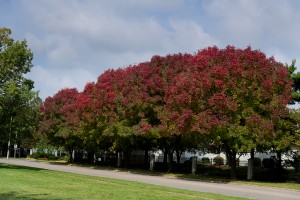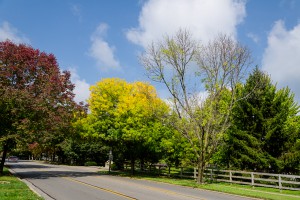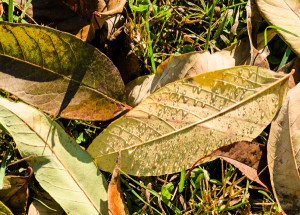
White ash, Fraxinus americana, at the historic Red Mile barn. Click pictures for a gallery of ash in autumn.
Ash trees, especially white ash, are among our most reliable and beautiful trees for fall color. White ash shows rich shades of red, purple, yellow and green, all within the same trees and the Biltmore ash variety is cloaked in yellow and orange hues. Green ash takes on an astonishingly bright yellow hue.
Sadly, the emerald ash borer is wiping out this brilliance. In some central Kentucky neighborhoods, most of the ash trees are already dead. The city of Lexington is beginning a program to remove dead and dying trees – a program that should have begun five years ago.
Some ash trees are being treated by their property owners, and these will remain in the landscape for some time. I suspect that many homeowners will eventually give up treating their trees, and the rest will die.
For now, we can enjoy the glorious colors of this iconic tree. Nothing can be done to slow the spread of emerald ash borer or to protect trees in the forest from the beetle. In urban areas, high-value trees can be protected. Foresters are now on a search for living white ash and green ash trees in places like southern Michigan, where the beetle has killed nearly all of the trees. If some living trees are found, it might be possible to select for resistance to the beetle,and, over the long run, return ash trees to their former glory.
Blue ash trees lack the spectacular colors of other ash species, their pale green fading to a mottled, subdued yellow. Although perhaps not as pretty a tree, blue ash are very abundant in the Bluegrass and very long lived. They are the most abundant of the Venerable Tree species that create our woodland pastures. The good news is that research in Michigan suggests that blue ash trees are largely resistant to emerald ash borer. It appears for now that we are likely to keep this very important tree.



Pingback: Good Urban Forestry For Resilient Cities, Part 1 - Planet Experts